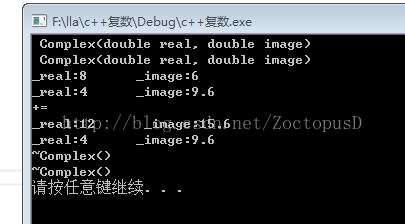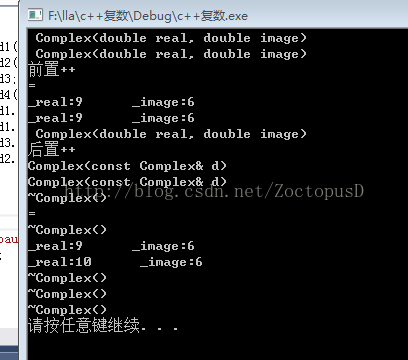Complex类的成员变量有实部与虚部:
protected:
double _real;
double _image;
本次将实现在C++中的Complex类的基本函数,包括四个默认成员函数,比较运算符重载函数,赋值运算符重载函数,以及前置++与后置++的重载。
四个默认成员函数是(1)构造函数:在定义对象时初始化成员变量,函数名与类名相同,无返回值(void也不能有),对象实例化时系统自动调用
(2)拷贝构造函数:是一种特殊的构造函数,是对构造函数的重载,用同类对象初始化成员变量
(3)析构函数:函数名是在类名前加~,无参数无返回值,函数作用是做一些清理工作,在对象生命周期结束时系统自动调用
(4)赋值运算符重载:operator+合法的运算符构成运算符重载
下面是编写的代码,在默认成员函数中我加上了一些输出,便于清楚看到成员函数是怎么运行的
#define _CRT_SECURE_NO_WARNINGS 1
#include<iostream>
using namespace std;
class Complex
{
public:
Complex(double real = 8.0, double image = 6.0) //构造函数
:_real(real)
, _image(image)
{
cout <<" Complex(double real, double image)" << endl;
}
Complex(const Complex& d) //拷贝函数
{
cout << "Complex(const Complex& d)" << endl;
_real = d._real;
_image = d._image;
}
~Complex() //析构函数
{
cout << "~Complex() " << endl;
_real = 0.0;
_image = 0.0;
}
Complex& operator=(const Complex& d) //赋值运算符重载
{
cout << "=" << endl;
if (this != &d)
{
_real = d._real;
_image = d._image;
}
return *this;
}
void Display()const //打印复数
{
cout << "_real:"<< _real;
cout << " _image:" << _image << endl;
}
bool operator==(const Complex& d) //==
{
cout << "==" << endl;
return this->_real == d._real
&& this->_image == d._image;
}
bool operator!=(const Complex& d) //!=
{
cout << "!=" << endl;
return this->_real != d._real
|| this->_image == d._image;
}
//复数只有当虚部为0时,即_image=0时,才可以比较大小,这时比较的是实部即_real的大小
bool operator>(const Complex& d) //>
{
if (this->_image != 0 || d._image != 0)
{
cout << "无法比较 " ;
return false;
}
else
{
return this->_real > d._real;
}
}
bool operator<(const Complex& d) //<
{
if (this->_image != 0 || d._image != 0)
{
cout << "无法比较 ";
return false;
}
else
{
return this->_real < d._real;
}
}
bool operator<=(const Complex& d) //<=
{
if (this->_image != 0 || d._image != 0)
{
cout << "无法比较 ";
return false;
}
else
{
return this->_real <= d._real;
}
}
bool operator>=(const Complex& d) //>=
{
if (this->_image != 0 || d._image != 0)
{
cout << "无法比较 ";
return false;
}
else
{
return this->_real >= d._real;
}
}
Complex operator+ (const Complex& d) //+
{
cout << "+" << endl;
Complex ret;
ret._real = (this->_real + d._real);
ret._image = (this->_image + d._image);
return ret;
}
Complex& operator+=(const Complex& d) //+=
{
cout << "+=" << endl;
this->_real += d._real;
this->_image += d._image;
return *this;
}
Complex& operator++() //前置++
{
cout << "前置++" << endl;
this->_real += 1;
return *this;
}
Complex operator++(int) //后置++
{
cout << "后置++" << endl;
Complex tmp(*this);
this->_real += 1;
return tmp;
}
protected:
double _real;
double _image;
};void Test()
{
Complex d1;
Complex d2(4.0,6.6);
d1.Display();
d2.Display();
//d1 = d2;
//d1.Display();
Complex d3;
d3 = d1 + d2;
cout << d1.operator==(d2) << endl;
cout << d1.operator!=(d2) << endl;
d3.Display();
}
我们可以看到系统调用函数的顺序,析构函数是清理工作,当生命周期结束时系统自动调用。
2、测试用例Test1()------------测试+=运算符
void Test1()
{
Complex d1;
Complex d2(4.0, 9.6);
d1.Display();
d2.Display();
d1 += d2;
d1.Display();
d2.Display();
}运行结果:

3、测试用例Test2()---------测试前置++与后置++
void Test2()
{
Complex d1;
Complex d2(0, 0);
d2 = ++d1;
d2.Display();
d1.Display();
Complex d3(1.0, 2.0);
d3 = d1++;
d3.Display();
d1.Display();
}
4、测试用例Test3()--------测试>/>=/</<=比较运算符
void Test3()
{
Complex d1(7,0);
Complex d2(6, 0);
Complex d3;
Complex d4(6, 0);
cout << d1.operator>(d2) << endl;
cout << d1.operator<(d2) << endl;
cout << d3.operator<=(d4) << endl;
cout << d2.operator>=(d4) << endl;
}
最后
以上就是可靠大炮最近收集整理的关于C++中的复数Complex类的全部内容,更多相关C++中内容请搜索靠谱客的其他文章。








发表评论 取消回复